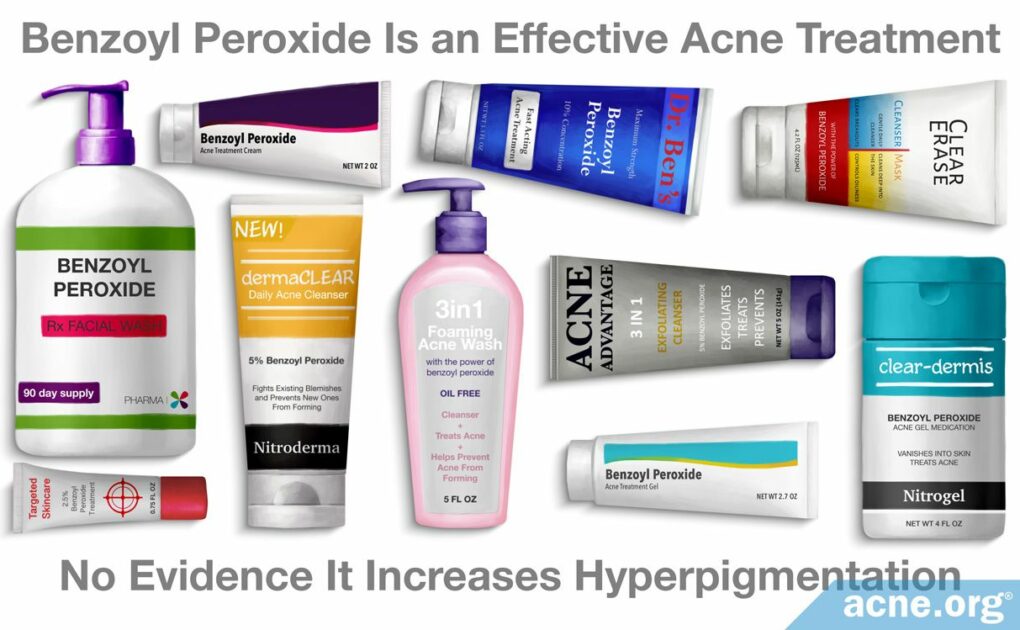There Is No Compelling Evidence of This to Date

The Essential Info
Benzoyl peroxide is a widely used and effective acne treatment that kills acne bacteria and unclogs skin pores. Although some people claim that benzoyl peroxide can increase hyperpigmentation (red/dark marks left after acne heals), the evidence that we have, while still weak and preliminary, would lead us to believe it does not in fact worsen hyperpigmentation.
It is possible that in rare cases, benzoyl peroxide might trigger skin irritation that could potentially result in worsened hyperpigmentation. Individuals with darker skin might be at greater risk of this unlikely side effect.
Dryness Can Lead to Temporarily Darker Skin: Many people over the years have emailed me saying benzoyl peroxide is giving them a “tan” or making their skin darker. This is due to what is called the “hardening effect” of benzoyl peroxide. Benzoyl peroxide comes with a lot of dryness for the first month or so until the skin becomes accustomed, or “hardened” to it. This dryness can make the skin appear to have a “tan” or to look darker. This should not be confused with hyperpigmentation. It is simply temporary dryness that subsides after a month or so.
The Bottom Line: There is no evidence that benzoyl peroxide makes hyperpigmentation worse, and on the flip side, when it is used correctly it can completely eliminate acne, thus preventing future acne lesions and future hyperpigmentation. To be extra-safe, keep your skin out of the sun if you are prone to hyperpigmentation when using, or for that matter when not using, benzoyl peroxide.

The Science
Benzoyl peroxide is one of the most effective acne treatments on the market today. It works by killing acne bacteria and preventing the clogging of skin pores, and it may possess anti-inflammatory and antioxidant properties.1-3
Many acne sufferers, particularly those with darker skin, develop darkened spots at the sites of healed acne lesions. This is called post-inflammatory hyperpigmentation. Hyperpigmentation can take months or, in some cases, even years to clear up, although there are treatments that can help speed up the process.4,5
The Evidence on Benzoyl Peroxide and Hyperpigmentation
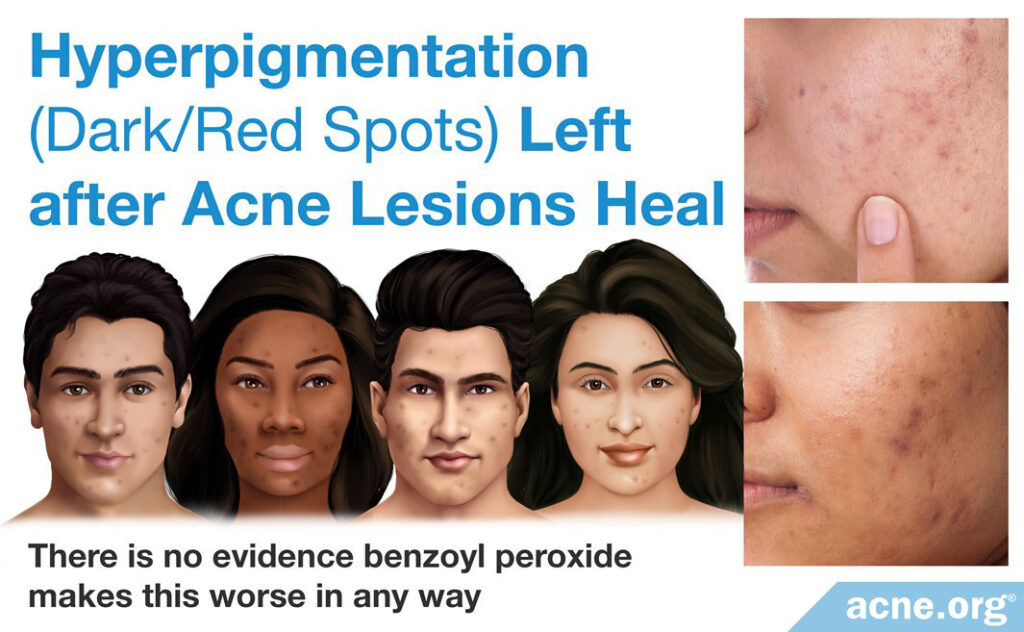
No clinical studies have directly investigated the link between applying only benzoyl peroxide to the skin and then testing for effects on hyperpigmentation. In other words, we have no trustworthy scientific data to show that benzoyl peroxide alone either does or does not worsen hyperpigmentation in people with acne.
The only scientific evidence we do have comes from:
- One case report (a description of interesting or unusual observations a doctor makes on one or a handful of patients): Scientists consider such reports a very weak type of evidence.
- One rigorous clinical study (a study in which researchers set out to test a specific treatment on a large number of patients): Scientists consider such studies reliable. However, the issue with this study is that the researchers were looking at a combination treatment, so benzoyl peroxide was not the only drug the patients used. In other words, this study does not give us any clear idea about what would happen if patients used benzoyl peroxide by itself.
But since this is all we have to go on, let’s have a look at the evidence and see what we can discern. Let’s take a look at the case report first.
Some very weak evidence that benzoyl peroxide might trigger hyperpigmentation in special cases not related to acne
In this case, doctors observed unusual hyperpigmentation on the chest of two black men who had been applying 5% benzoyl peroxide to treat acne. The men first developed a rash on the chest and, after they stopped benzoyl peroxide treatment, the rash converted into a network pattern of hyperpigmentation (expand the drawer below to see). The doctors concluded that benzoyl peroxide irritated the patients’ skin, triggering a rash and, later, hyperpigmentation.6
It is important to note that the pattern of hyperpigmentation in these two patients looked very different from what normally occurs with acne. In other words, these were two very unusual cases, and no other doctors have reported on anything similar happening with their patients.
Expand to read details of case report

The case report was published in 1998 in the journal Acta Dermato-Venereologica. The report described two black male patients, aged 29 and 31, who developed red scaly rash on the chest while using 5% benzoyl peroxide to treat chest acne. When the patients stopped applying benzoyl peroxide, the rash changed into a fine network of dark brown hyperpigmentation on the chest. The doctors performed a biopsy, which involves taking a small sample of skin and examining it under the microscope, on both patients. The biopsy confirmed that the patients had post-inflammatory hyperpigmentation caused by contact dermatitis (rash due to contact with an irritating substance). The doctors concluded that benzoyl peroxide caused skin irritation, which triggered hyperpigmentation in the patients.6
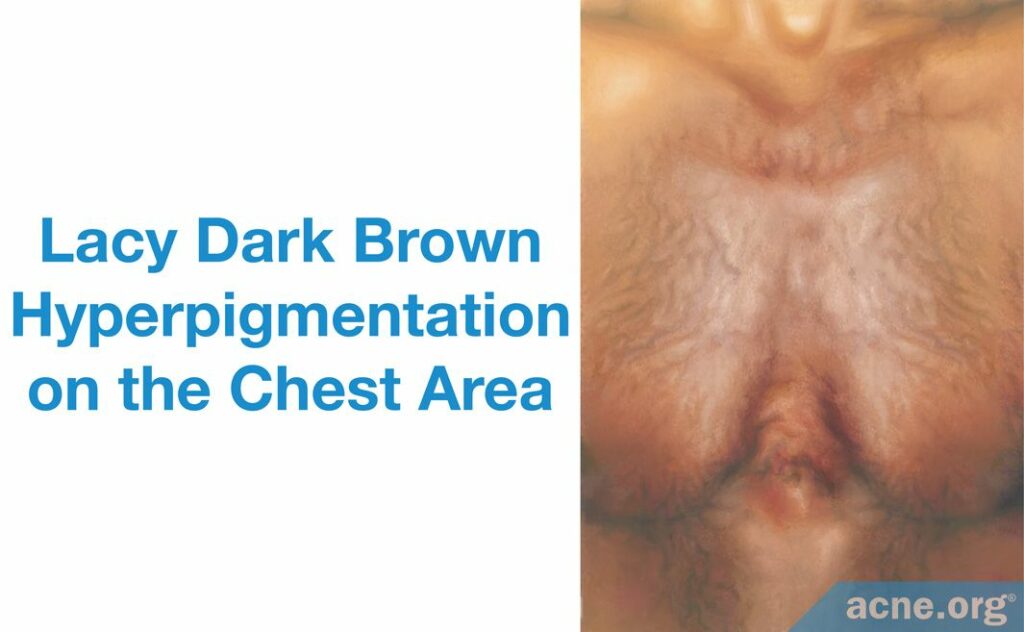
Fine network of dark brown hyperpigmentation across the chest6
Now, let’s look at the clinical study, in which doctors treated acne sufferers with benzoyl peroxide in combination with another drug.
Some evidence that benzoyl peroxide does not trigger hyperpigmentation
A recent study that tested a treatment containing 2.5% benzoyl peroxide together with another topical medication (adapalene) on black patients and found no hyperpigmentation resulting from the treatment in any of the patients.7 Since the study was highly rigorous, this result is encouraging. However, because the treatment contained another drug in addition to benzoyl peroxide, we cannot be absolutely certain that benzoyl peroxide alone would have produced the same results.
Expand to read details of study

The study was published in 2014 in the Journal of Drugs in Dermatology. It was a large clinical trial to test the efficacy and safety of a topical combination treatment containing 0.1% adapalene and 2.5% benzoyl peroxide in black patients. The researchers reported that none of the patients developed post-inflammatory hyperpigmentation as a result of the treatment.7
The verdict on benzoyl peroxide and hyperpigmentation
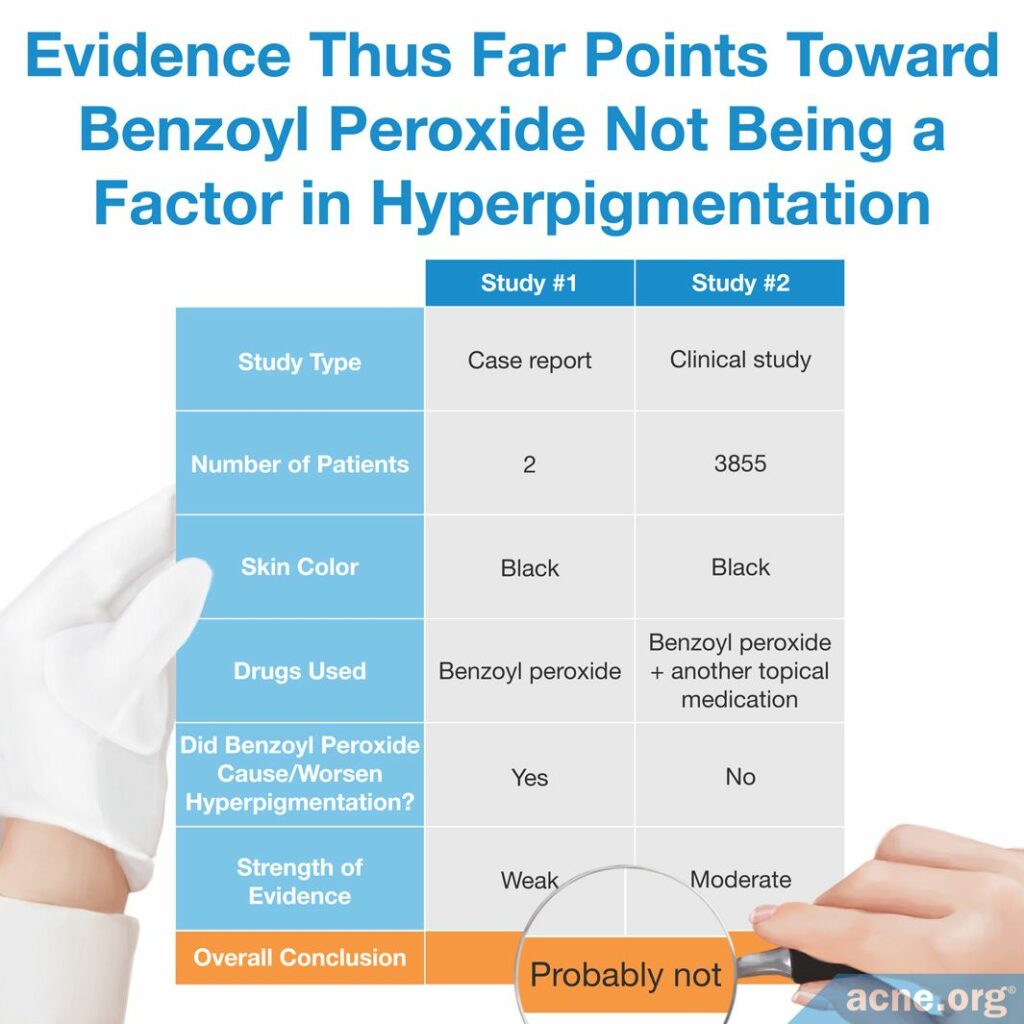
To sum up, until researchers conduct a large-scale study looking specifically at applying only benzoyl peroxide to the skin and its effects on hyperpigmentation, we will not know for sure whether benzoyl peroxide might make hyperpigmentation worse, but the evidence thus far points toward benzoyl peroxide not being a factor in this area.
Is it even theoretically possible that benzoyl peroxide could cause such a problem?
To understand how benzoyl peroxide might theoretically increase hyperpigmentation, we need to understand why hyperpigmentation occurs in people with acne in the first place.
What causes hyperpigmentation in acne?
Hyperpigmentation in acne is somehow linked to inflammation. Inflammation, which is part and parcel of acne, triggers a chain of events that can result in darkened spots, particularly in darker-skinned people. We do not know exactly how this occurs.
Scientists speculate that, in some cases, benzoyl peroxide might theoretically cause extra inflammation, and in that way potentially make hyperpigmentation worse. Keep in mind that this is all speculation at this point. But how would it even work?
Why might benzoyl peroxide cause additional inflammation?
The evidence on benzoyl peroxide and inflammation is contradictory.
On the one hand, some research suggests that benzoyl peroxide reduces inflammation in people with acne.3 This would imply that benzoyl peroxide should improve hyperpigmentation rather than make it worse.
On the other hand, some researchers have found that benzoyl peroxide can occasionally cause skin inflammation, resulting in skin redness, dryness, and scaling.8 Such a reaction to benzoyl peroxide is relatively rare and affects approximately 1 out of every 500 individuals.2 In other words, in a very small number of people, benzoyl peroxide can trigger a strong inflammatory reaction, which might, in theory, make hyperpigmentation worse.
In summary, while there is no direct evidence that benzoyl peroxide can increase hyperpigmentation, it is possible that such a side effect might occur in rare cases.
How Common Is Hyperpigmentation in Acne?
Do you even need to worry about developing hyperpigmentation in the first place? This will largely depend on your skin tone.
While hyperpigmentation due to acne is common, people with darker skin are particularly likely to experience it. Dermatologists evaluate the shade of a person’s skin on the so-called Fitzpatrick scale.
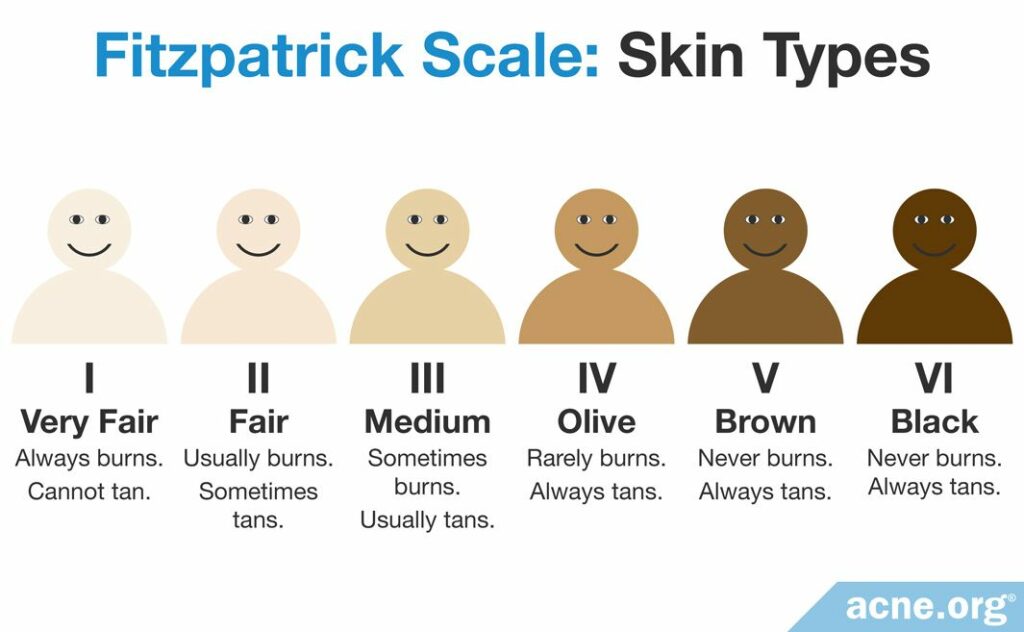
People with skin types 4 and higher are more likely to develop hyperpigmentation due to acne.

A study published in the Journal of the American Academy of Dermatology in 2002 looked at the frequency of hyperpigmentation in acne patients of different races, and found that 65.3% of African-American, 52.7% of Hispanic, and 47.4% of Asian patients developed hyperpigmentation due to acne.5
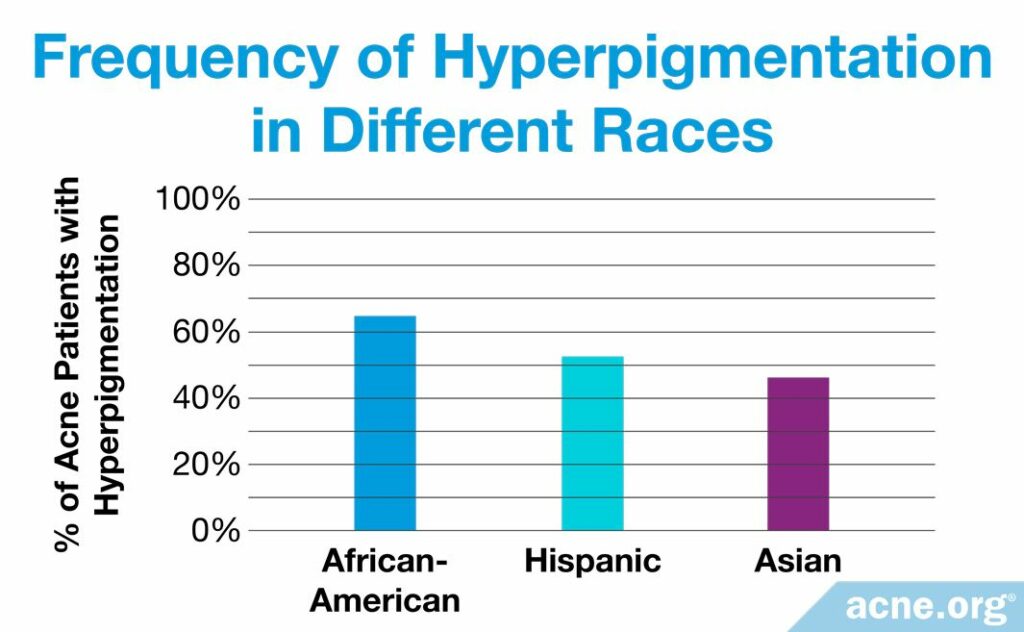
In other words, approximately half or slightly more than half of acne sufferers with darker skin develop some hyperpigmentation. However, there is no evidence that treating acne with benzoyl peroxide makes hyperpigmentation any more likely.
How Does Hyperpigmentation Occur?
Since hyperpigmentation due to acne is fairly common, you may be curious how it develops. As you read this, keep in mind that as far as we know, benzoyl peroxide has no effect on hyperpigmentation.
The skin contains specialized cells called melanocytes that produce the dark pigment melanin. Hyperpigmentation can occur for one, or both, of the following reasons:
- Some melanocytes produce too much pigment, creating a concentration of dark color around them
- Sometimes, pigment is unevenly distributed through the skin, resulting in some spots with too much dark color
Scientists do not know exactly why melanocytes sometimes begin producing too much pigment or why pigment might become unevenly distributed, but it is clear that inflammation somehow triggers this process.5,9 In addition, we know that exposure to the sun’s rays can intensify hyperpigmentation.
The exact appearance of hyperpigmentation depends on where in the skin the extra pigment settles. Pigment that accumulates in the epidermis (the upper layer of the skin) results in tan or brown spots, which can last for months or even years if untreated. Pigment that settles deeper, in the dermis of the skin, causes bluish-gray pigmentation that takes even longer to disappear and can even be permanent.5
Other Causes of Hyperpigmentation
Many skin conditions besides acne can trigger inflammation and result in hyperpigmentation. These include:
- Allergic and contact dermatitis (rashes resulting from an allergy-causing or irritating substance)
- Lichen planus (an inflammatory condition resulting in purple bumps on the skin)
- Impetigo (a skin infection)
- Psoriasis (a chronic condition resulting in a scaly rash)
- Skin injuries and burns5,9
In addition, certain cosmetic procedures, such as dermabrasion and laser resurfacing, and some drugs can trigger hyperpigmentation.4
Other Side Effects of Benzoyl Peroxide
We have no evidence that benzoyl peroxide worsens hyperpigmentation. However, let’s look at other side effects that benzoyl peroxide treatment can cause.
Generally, patients tolerate benzoyl peroxide well, and side effects are rare and temporary. The most common side effect is skin irritation, which can include skin dryness, mild swelling, redness, and scaling of the skin, particularly in the first few weeks of treatment.2 One study found that such skin reactions to benzoyl peroxide occurred in 5.1% of patients, while another observed weak reactions in 6.5% of patients and strong reactions in 1.3% of patients.8 In rare cases, continued use can lead to an escalation of symptoms, occasionally resulting in severe dermatitis.10,11
The Bottom Line
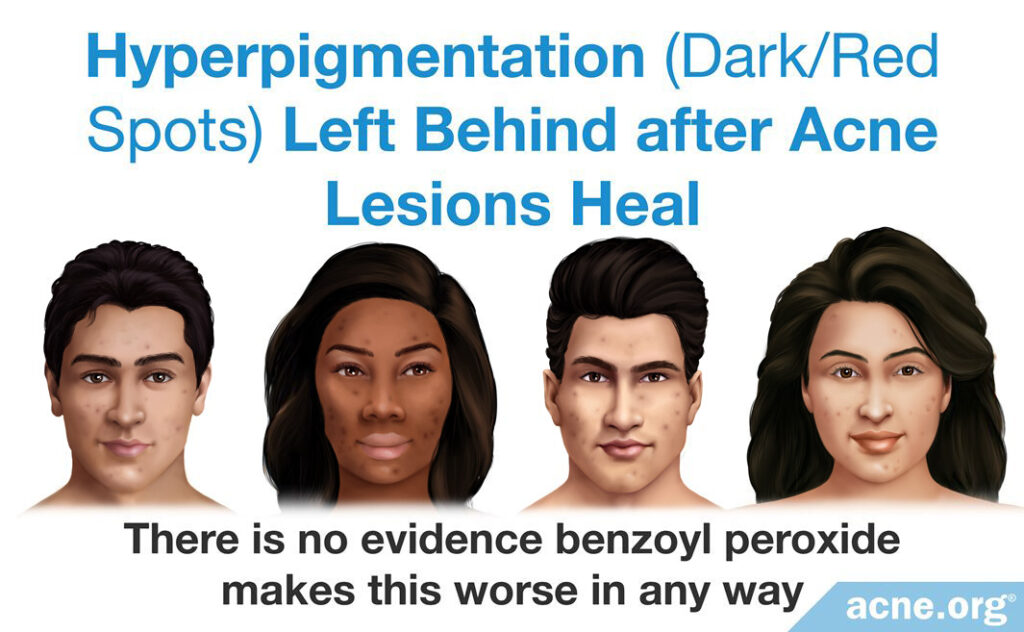
Benzoyl peroxide is a widespread and effective topical treatment for acne. Despite a few claims online that benzoyl peroxide can make hyperpigmentation worse, there is no reliable evidence that this actually occurs. We will monitor new research as it comes out, but for now, there is no reason for concern.
References
- Sawleshwarkar, S. N., Salgaonkar, V. & Oberai, C. M. Multicenter study to evaluate efficacy and irritation potential of benzoyl peroxide 4% cream in hydrophase base (Brevoxyl) in acne vulgaris. Indian J Dermatol Venereol Leprol 69, 19 – 22 (2003). https://www.ncbi.nlm.nih.gov/pubmed/17642816
- Decker, A. & Graber, E. M. Over-the-counter Acne Treatments: A Review. J Clin Aesthet Dermatol 5, 32 – 40 (2012). https://www.ncbi.nlm.nih.gov/pubmed/22808307
- Draelos, Z. Irritation Profile of Benzoyl Peroxide Acne Washes: Impact of Formulation. Cosmet Dermatol 23, 541 – 547 (2010). https://www.mdedge.com/dermatology/article/69908/acne/irritation-profile-benzoyl-peroxide-acne-washes-impact-formulation
- Patel, A. B. Postinflammatory hyperpigmentation: Review of pathogenesis, prevention, and treatment. Pigment Int 1, 59 – 69 (2014). http://www.pigmentinternational.com/article.asp?issn=2349-5847;year=2014;volume=1;issue=2;spage=59;epage=69;aulast=Patel
- Davis, E. C. & Callender, V. D. Postinflammatory hyperpigmentation: a review of the epidemiology, clinical features, and treatment options in skin of color. J Clin Aesthet Dermatol 3, 20 – 31 (2010). https://www.ncbi.nlm.nih.gov/pubmed/20725554
- Weinberg, J. M., Moss, T., Gupta, S. M., White, S. M. & Don, P. C. Reticulate hyperpigmentation of the skin after topical application of benzoyl peroxide. Acta Derm Venereol 78, 301 – 302 (1998). https://www.ncbi.nlm.nih.gov/pubmed/9689304
- Lawson, C. N. et al. Updates in the understanding and treatments of skin & hair disorders in women of color. Int J Womens Dermatol 3, S21 – S37 (2017). https://www.ncbi.nlm.nih.gov/pubmed/28492036
- Foti, C. et al. Contact dermatitis to topical acne drugs: a review of the literature. Dermatol Ther 28, 323 – 329 (2015). https://www.ncbi.nlm.nih.gov/pubmed/26302055
- Grimes, P. E. Management of hyperpigmentation in darker racial ethnic groups. Semin Cutan Med Surg 28, 77 – 85 (2009). https://www.ncbi.nlm.nih.gov/pubmed/19608057
- Felton, S. J., Orton, D. & Williams, J. D. Benzoyl peroxide in topical acne preparations: an underreported contact allergen? Dermatitis 24, 146 – 7 (2013). https://www.ncbi.nlm.nih.gov/pubmed/23665828
- Kim, C., Craiglow, B. G., Watsky, K. L. & Antaya, R. J. Allergic Contact Dermatitis to Benzoyl Peroxide Resembling Impetigo. Pediatr Dermatol 32, e161 – 162 (2015). https://www.ncbi.nlm.nih.gov/pubmed/25782705
 Acne.org Products
Acne.org Products